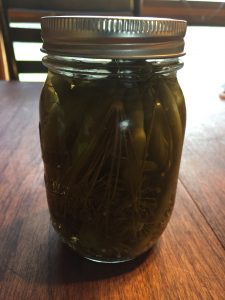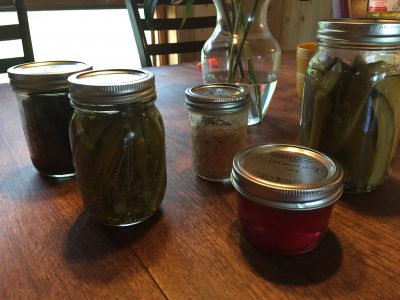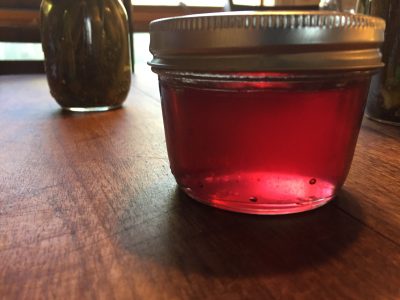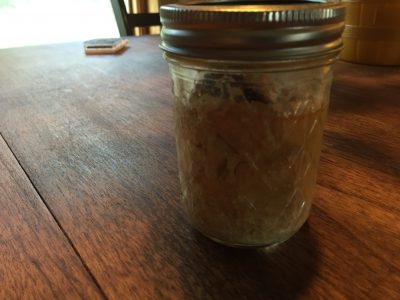Every Alaskan gardener eventually runs up against the end of the season and a plethora of produce. Then comes the problem of what to do with it to actually get people to consume it!
I’ve heard of people dropping extra zucchini on unsuspecting door steps, and even putting them in random cars in the parking lot. You’re tired of “zuke dogs” right, you couldn’t grill another zuke, or deep fry it to save your life at this point. You’ve had kale every which way that can be imagined. You’ve had bush beans by the bushel. Your children and friends may be planning a mutiny. Let’s be real. This isn’t a blog post, it’s an intervention.
Pickling your produce may just restore your relationships as well as your appetite and culinary daring. Any person can go down to the local market and get a cucumber pickle. You can even get ‘artisanal’ cucumber pickles. But I want to let you in on a secret. They’re all terrible compared to pickles you can make at home using bush beans and yes, the dreadedly prolific zucchini. Cabbage can be pickled to lift up those fish dishes, and give your fish tacos some zing. Bickles, Zickles, and Cickles can’t be found as easily at the corner market, and they’re so good they can be used as gifts.

Pickling adds diversity to your larder, and it helps store and preserve food without taking up valuable freezer space. It provides a crispy texture in your vegetables that blanching and freezing doesn’t. There are also numerous health benefits in pickling your foods by traditional fermentation techniques, one of which is restoring healthy gut bacteria to your system which is essential for good health. Taking on those techniques utilizing bacteria to form lactic acid, and the monitoring that is required can be a big first step though. I think a more fun, and easy first step into the world of pickling is making bickles for those bloody mary’s or, caesars.

I like to pickle the same day I pick. I pick the beans and wash them thoroughly. I gather the necessary ingredients: white vinegar, pickling salt, fresh dill (preferably from your garden!), garlic, and coriander. I sterilize my jars by boiling them in my canner for a few minutes. I fill a pot with half white vinegar and half tap water, and bring it to a boil, in goes the kosher salt to completely dissolve forming the brine. I add a garlic clove and a good sprig of garlic to each jar as well as a pinch of coriander seed (a little goes a long way), additionally you can add a jalapeño to each jar, or some red pepper flakes to give it that extra zing. Everyone I’ve met definitely prefers the spicy bickles over the plain ones. I pack the jars with green beans leaving some space at the top of each jar. Cover the beans with the hot brine. At this point you can put your bickle in the refrigerator and let it pickle, and it will be ready in about two weeks to eat. They have to be submerged the entire time so you may need to put something on top of them to keep them down in the brine. They’ll keep like this for about six months, as long as you scoop the ‘foam’ off the top and they’re stilling passing the very scientific “sniff test”. However, refrigerator space in my family of six comes at a premium, so I can most of my jars by putting them in a boiling water canner (as opposed to a pressure canner) and cover them with water and boil them for ten minutes. Before I put the cans into the canner I make sure the lids and the edge of the glass are dry to get a good seal, and are finger tip tight, not too tight. After ten minutes of boiling pull them out and add your next batch. I like to use pint jars for bickles.
At this point you’re thinking to yourself, this guy doesn’t even give me measurements! Well, I don’t know how many beans you’re going to pickle, or your tolerance for vinegar, so I prefer to give ratios as a starting point:

If you have 2 cups of water, you’ll need 2 cups of vinegar, and 1/4 cup of Kosher pickling salt. So with that as a baseline you can infer that you have 8 cups of water you’ll need 8 cups of vinegar and yes, 2 cups of Kosher pickling salt. As long as you keep the ratio of water:vinegar:salt consistent, you can experiment with the rest. You can make “Karen’s Bickle #3” or “Bob’s Bickle #22” with different variations, keep a notepad so you know what you did for each batch so you can hone your recipe in on what you and your family and friends like. I’ve made batches that were too tart for me, too much vinegar, or too much ‘spice’ (especially when you use pre-packaged ‘pickling spice’!).


Now the exact same process applies to zucchini as well, except I prefer to use quart jars for zickles, and zickles have to be cut into spears. The skin on a zickle is thicker than a pickle and you’ll want to have them in spears. Trust me. Now that you have the canner (pressure canner that is) going full throttle why not make canned salmon, it beats the heck out of adding tuna fish to those recipes in December and February. Why not make some canned Fireweed jelly? Well, because you have more pickling to do that’s why!
Check out these recipes for ideas, but don’t get boxed in (obviously saffron is hard to come by in the bush!).
https://allrecipes.com/recipe/62594/crisp-pickled-green-beans/
https://www.foodiecrush.com/dilly-bean-recipe-10-pickle-recipes-love/
https://www.myrecipes.com/recipe/quick-pickled-cabbage
https://www.epicurious.com/recipes/food/views/zucchini-dill-pickles-366756
For more recipes and tips on safe food preservation methods, go to Cooperative Extension’s Food Preservation Site.
About ecalexander
Twitter •
Yum! Thanks for the info!
I can’t wait to try your recipes! Now, if only people would randomly leave their produce on my doorstep….